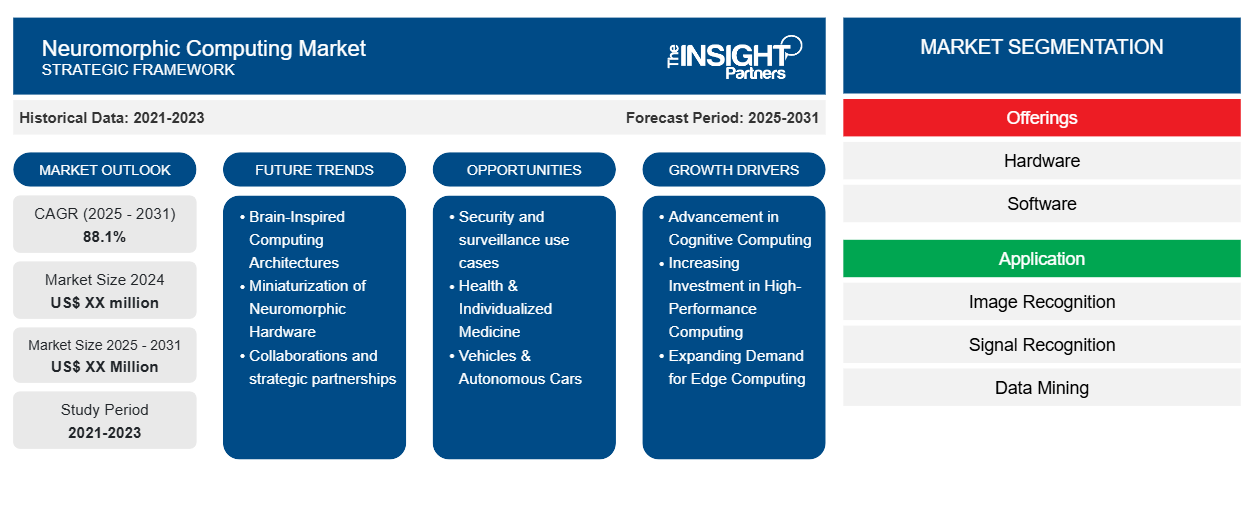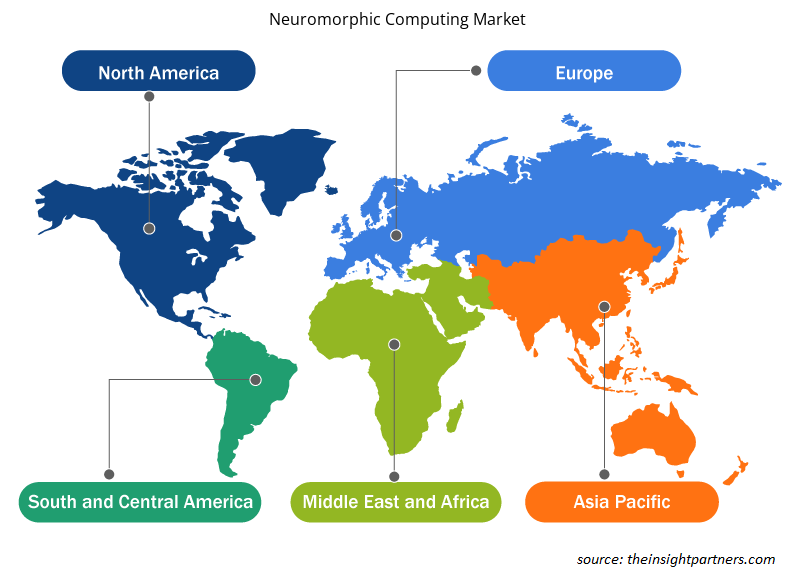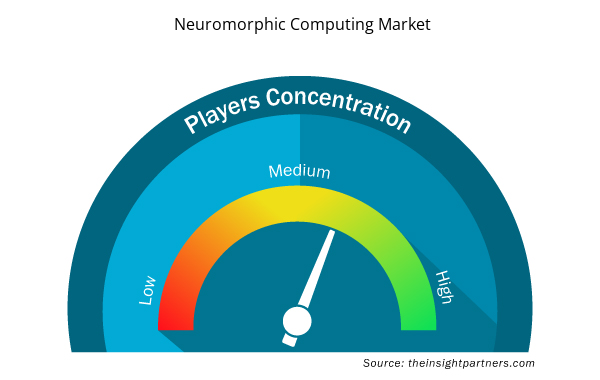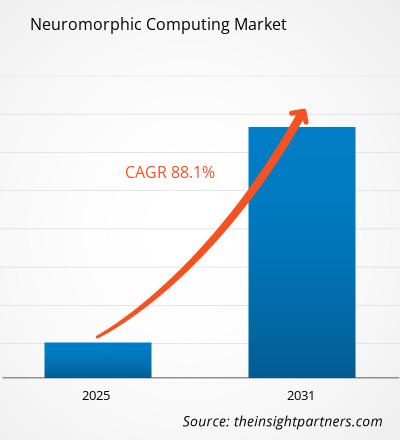The Neuromorphic Computing Market is expected to register a CAGR of 88.1% from 2025 to 2031, with a market size expanding from US$ XX million in 2024 to US$ XX Million by 2031.
The Neuromorphic Computing Market report is categorized by offerings into the following subsegments: Hardware and Software. It further presents an analysis based on application, i.e., Image Recognition, Signal Recognition, and Data Mining. The end-user industries are segmented as Aerospace, IT and Telecom, Medical, Automotive, and Industrial. The global analysis is broken down at the regional level and major countries. The market evaluation is presented in US$ for the above segmental analysis.
Purpose of the Report
The report Neuromorphic Computing Market by The Insight Partners aims to describe the present landscape and future growth, top driving factors, challenges, and opportunities. This will provide insights to various business stakeholders, such as:
- Technology Providers/Manufacturers: To understand the evolving market dynamics and know the potential growth opportunities, enabling them to make informed strategic decisions.
- Investors: To conduct a comprehensive trend analysis regarding the market growth rate, market financial projections, and opportunities that exist across the value chain.
- Regulatory bodies: To regulate policies and police activities in the market with the aim of minimizing abuse, preserving investor trust and confidence, and upholding the integrity and stability of the market.
Neuromorphic Computing Market Segmentation
Offerings
- Hardware
- Software
Application
- Image Recognition
- Signal Recognition
- Data Mining
End-User Industry
- Aerospace and Defense
- IT and Telecom
- Medical
- Automotive
- Industrial
- Others
Geography
- North America
- Europe
- Asia-Pacific
- South and Central America
- Middle East and Africa
Customize This Report To Suit Your Requirement
You will get customization on any report - free of charge - including parts of this report, or country-level analysis, Excel Data pack, as well as avail great offers and discounts for start-ups & universities
Neuromorphic Computing Market: Strategic Insights

- Get Top Key Market Trends of this report.This FREE sample will include data analysis, ranging from market trends to estimates and forecasts.
Neuromorphic Computing Market Growth Drivers
- Advancement in Cognitive Computing: Neuromorphic computing is brain-like computing that works similarly to the brain of a machine. This allows for cognitive computing systems that are smarter, more adaptive, and more efficient - increasing demand from any industry that needs self-teaching smart systems such as medical diagnostics or autonomous systems.
- Increasing Investment in High-Performance Computing: Rising investments in high-performance computing (HPC) applications — in defense, aerospace, automotive, and more — drive the need for faster, more scalable computing platforms. Neuromorphic computing also gives us better computational power for the very challenging tasks that existing computers can’t do.
- Expanding Demand for Edge Computing: The explosion of edge computing requires applications that can work locally without dependently on the cloud. Neuromorphic computing allows faster processing and real-time decisions at the edge and is a prime reason why industries look to optimize performance and reduce latency.
Neuromorphic Computing Market Future Trends
- Brain-Inspired Computing Architectures: The one major development in the neuromorphic computing market is to go for brain-inspired computing architectures. These systems replicate neural networks in the brain to enable machine learning to become faster, more efficient and adaptive. As corporations adopt such powers, they’re investing in neuromorphic chips and hardware.
- Miniaturization of Neuromorphic Hardware: Neuromorphic hardware is becoming more miniaturized to make it feasible to use in smaller devices, especially in IoT. Miniaturization also saves power and the technology can be deployed into many more industries from wearables to embedded robotic systems.
- Collaborations and strategic partnerships: The neuromorphic computing market is seeing more and more collaborations and strategic partnerships between IT firms, research institutions, and governments. These partnerships are focused on building neuromorphic hardware and software and scaling the technology’s potential in a variety of markets including healthcare, aerospace, and automotive.
Neuromorphic Computing Market Opportunities
- Security and surveillance use cases: Massive security and surveillance use cases expose the full power of neuromorphic computing, real-time recognition, and learning. Anomaly detection, threat detection, and risk management use cases include police/military and large-scale surveillance systems.
- Health & Individualized Medicine: Neuromorphic computing is currently doing big business in health, with individualized medicine, imaging, and diagnosis. Learning from the data and granular real-time feedback can be invaluable in such things as disease detection, drug discovery, or robotic surgery.
- Vehicles & Autonomous Cars: Neuromorphic Computing Systems are suited for Autonomous Cars as they calculate the sense information in real-time. It could control navigation, choices, and interfaces with the world — that’s a lot of opportunity for automakers and tech vendors in the driverless driving market.
Neuromorphic Computing Market Regional Insights
The regional trends and factors influencing the Neuromorphic Computing Market throughout the forecast period have been thoroughly explained by the analysts at Insight Partners. This section also discusses Neuromorphic Computing Market segments and geography across North America, Europe, Asia Pacific, Middle East and Africa, and South and Central America.

- Get the Regional Specific Data for Neuromorphic Computing Market
Neuromorphic Computing Market Report Scope
| Report Attribute | Details |
|---|---|
| Market size in 2024 | US$ XX million |
| Market Size by 2031 | US$ XX Million |
| Global CAGR (2025 - 2031) | 88.1% |
| Historical Data | 2021-2023 |
| Forecast period | 2025-2031 |
| Segments Covered |
By Offerings
|
| Regions and Countries Covered | North America
|
| Market leaders and key company profiles |
Neuromorphic Computing Market Players Density: Understanding Its Impact on Business Dynamics
The Neuromorphic Computing Market market is growing rapidly, driven by increasing end-user demand due to factors such as evolving consumer preferences, technological advancements, and greater awareness of the product's benefits. As demand rises, businesses are expanding their offerings, innovating to meet consumer needs, and capitalizing on emerging trends, which further fuels market growth.
Market players density refers to the distribution of firms or companies operating within a particular market or industry. It indicates how many competitors (market players) are present in a given market space relative to its size or total market value.
Major Companies operating in the Neuromorphic Computing Market are:
- Applied Brain Research, Inc.
- Brainchip Holdings Ltd.
- General Vision Inc.
- Hewlett Packard Enterprise
- HRL Laboratories, LLC
Disclaimer: The companies listed above are not ranked in any particular order.

- Get the Neuromorphic Computing Market top key players overview
Key Selling Points
- Comprehensive Coverage: The report comprehensively covers the analysis of products, services, types, and end users of the Neuromorphic Computing Market, providing a holistic landscape.
- Expert Analysis: The report is compiled based on the in-depth understanding of industry experts and analysts.
- Up-to-date Information: The report assures business relevance due to its coverage of recent information and data trends.
- Customization Options: This report can be customized to cater to specific client requirements and suit the business strategies aptly.
The research report on the Neuromorphic Computing Market can, therefore, help spearhead the trail of decoding and understanding the industry scenario and growth prospects. Although there can be a few valid concerns, the overall benefits of this report tend to outweigh the disadvantages.
- Historical Analysis (2 Years), Base Year, Forecast (7 Years) with CAGR
- PEST and SWOT Analysis
- Market Size Value / Volume - Global, Regional, Country
- Industry and Competitive Landscape
- Excel Dataset



Report Coverage
Revenue forecast, Company Analysis, Industry landscape, Growth factors, and Trends

Segment Covered
This text is related
to segments covered.

Regional Scope
North America, Europe, Asia Pacific, Middle East & Africa, South & Central America

Country Scope
This text is related
to country scope.
Frequently Asked Questions
The report can be delivered in PDF/PPT format; we can also share excel dataset based on the request.
Some of the customization options available based on request are additional 3-5 company profiles and country-specific analysis of 3-5 countries of your choice. Customizations are to be requested/discussed before making final order confirmation, as our team would review the same and check the feasibility.
Future trends include the development of neuromorphic chips with improved energy efficiency, the integration of neuromorphic computing in edge AI applications, and increased investment in neuromorphic systems for real-time learning and decision-making processes.
Leading players include: Applied Brain Research, Inc., Brainchip Holdings Ltd, General Vision Inc., Hewlett Packard Enterprise, HRL Laboratories, LLC, IBM Corporation, Intel Corp., Numenta, Qualcomm Inc., Samsung Electronics Limited,
The market is anticipated to grow at a 88.1% CAGR in 2023-2031
The key growth drivers for the neuromorphic computing market include the increasing demand for artificial intelligence (AI) and machine learning, advancements in cognitive computing, rising investments in high-performance computing, and the growing need for edge computing in industries such as healthcare, automotive, and IoT.
Trends and growth analysis reports related to Technology, Media and Telecommunications : READ MORE..
1. Applied Brain Research, Inc.
2. Brainchip Holdings Ltd.
3. General Vision Inc.
4. Hewlett Packard Enterprise
5. HRL Laboratories, LLC
6. IBM Corporation
7. Intel Corp.
8. Numenta
9. Qualcomm Inc.
10. Samsung Electronics Limited

 Get Free Sample For
Get Free Sample For